Quinine
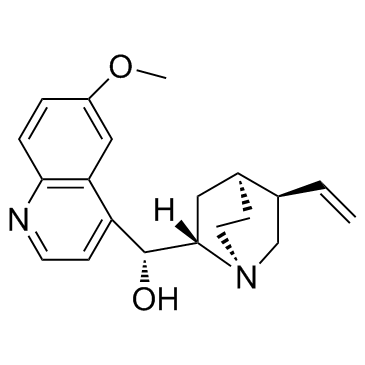
Quinine structure
|
Common Name | Quinine | ||
|---|---|---|---|---|
| CAS Number | 130-95-0 | Molecular Weight | 324.417 | |
| Density | 1.2±0.1 g/cm3 | Boiling Point | 495.9±40.0 °C at 760 mmHg | |
| Molecular Formula | C20H24N2O2 | Melting Point | 176-177ºC | |
| MSDS | Chinese USA | Flash Point | 253.7±27.3 °C | |
| Symbol |

GHS08 |
Signal Word | Danger | |
Use of QuinineQuinine is an anti-malaria agent and also a potassium channel inhibitor with an IC50 of 169 μM. |
| Name | quinine |
|---|---|
| Synonym | More Synonyms |
| Description | Quinine is an anti-malaria agent and also a potassium channel inhibitor with an IC50 of 169 μM. |
|---|---|
| Related Catalog | |
| Target |
IC50: 169 μM (potassium channel)[1] Parasite[2] |
| References |
| Density | 1.2±0.1 g/cm3 |
|---|---|
| Boiling Point | 495.9±40.0 °C at 760 mmHg |
| Melting Point | 176-177ºC |
| Molecular Formula | C20H24N2O2 |
| Molecular Weight | 324.417 |
| Flash Point | 253.7±27.3 °C |
| Exact Mass | 324.183777 |
| PSA | 45.59000 |
| LogP | 3.44 |
| Vapour Pressure | 0.0±1.3 mmHg at 25°C |
| Index of Refraction | 1.638 |
CHEMICAL IDENTIFICATION
HEALTH HAZARD DATAACUTE TOXICITY DATA
MUTATION DATA
|
| Symbol |

GHS08 |
|---|---|
| Signal Word | Danger |
| Hazard Statements | H315-H317-H319-H334 |
| Precautionary Statements | P261-P280-P284-P304 + P340-P305 + P351 + P338-P342 + P311 |
| Personal Protective Equipment | dust mask type N95 (US);Eyeshields;Faceshields;Gloves |
| Hazard Codes | Xn:Harmful |
| Risk Phrases | R22;R36/37/38 |
| Safety Phrases | S26-S37/39 |
| RIDADR | UN 1544 |
| WGK Germany | 3 |
| RTECS | VA6020000 |
| Packaging Group | III |
| Hazard Class | 6.1(b) |
| HS Code | 29392110 |
| Precursor 0 | |
|---|---|
| DownStream 10 | |
| HS Code | 29392110 |
|---|
|
Enhancing perception of contaminated food through acid-mediated modulation of taste neuron responses.
Curr. Biol. 24(17) , 1969-77, (2014) Natural foods contain not only nutrients, but also nonnutritious and potentially harmful chemicals. Thus, animals need to evaluate food content in order to make adequate feeding decisions.Here, we inv... |
|
|
Synthesis and Characterization of 8-O-Carboxymethylpyranine (CM-Pyranine) as a Bright, Violet-Emitting, Fluid-Phase Fluorescent Marker in Cell Biology.
PLoS ONE 10 , e0133518, (2015) To avoid spectral interference with common fluorophores in multicolor fluorescence microscopy, a fluid-phase tracer with excitation and emission in the violet end of the visible spectrum is desirable.... |
|
|
Glycation of human cortical and cancellous bone captures differences in the formation of Maillard reaction products between glucose and ribose.
PLoS ONE 10(2) , e0117240, (2015) To better understand some aspects of bone matrix glycation, we used an in vitro glycation approach. Within two weeks, our glycation procedures led to the formation of advanced glycation end products (... |
| (R)-[(2S,4S,5R)-5-éthènyl-1-azabicyclo[2.2.2]oct-2-yl](6-méthoxy-4-quinoléinyl)méthanol |
| (-)-Quinine |
| 6'-Methoxycinchonidine |
| Kinin |
| cinchonan-9-ol, 6'-methoxy-, (8a,9R)- |
| Kinidin-d3 |
| Quinina |
| (R)-(6-Methoxyquinolin-4-yl)((1R,2R,4R,5S)-5-vinylquinuclidin-2-yl)methanol |
| chinine |
| Cinchonan-9-ol, 6'-methoxy-, (8α,9R)- |
| MFCD00198096 |
| (R)-(6-Methoxy-4-chinolinyl)[(2S,4S,5R)-5-vinyl-1-azabicyclo[2.2.2]oct-2-yl]methanol |
| (R)-(6-Methoxy-4-quinolinyl)[(2S,4S,5R)-5-vinyl-1-azabicyclo[2.2.2]oct-2-yl]methanol |
| Chinin |
| (8S,9R)-6'-Methoxycinchonan-9-ol |
| (R)-(-)-Quinine |
| EINECS 205-003-2 |
| (8a,9R)-6'-methoxycinchonan-9-ol |
| Cinchonan-9-ol, 6'-methoxy-, (8alpha,9R)- |
| QUININE |
| Pitayin-d3 |
| UNII-A7V27PHC7A |
| (8α,9R)-6'-Methoxycinchonan-9-ol |
| Quinie |
 CAS#:109906-48-1
CAS#:109906-48-1 CAS#:41037-26-7
CAS#:41037-26-7 CAS#:612-11-3
CAS#:612-11-3 CAS#:490-11-9
CAS#:490-11-9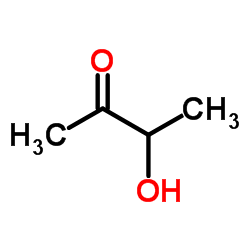 CAS#:513-86-0
CAS#:513-86-0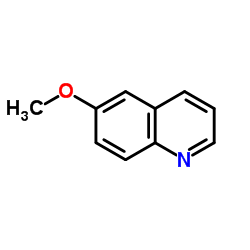 CAS#:5263-87-6
CAS#:5263-87-6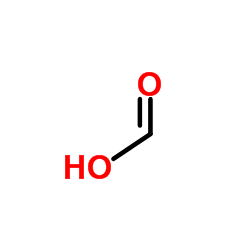 CAS#:64-18-6
CAS#:64-18-6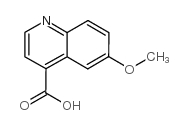 CAS#:86-68-0
CAS#:86-68-0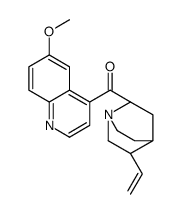 CAS#:84-31-1
CAS#:84-31-1 CAS#:78-97-7
CAS#:78-97-7
